Updated March, 2025
The Bible is a masterful book inspired by God. Themes, colorful characters, subplots, foreshadowings, prophecy, fulfillment, and literary balance shape this living book, an endless treasure. The Bible holds these components together through story, symbol, and metaphor. Some symbols are used only once: a burning bush, a withered fig tree. Other symbols span the Bible: trees, angels, mountains, rivers, rainbows…and birds.
The Bible is a veritable aviary! Genesis begins by describing a time when darkness and nothingness prevailed, but out of nothingness there was God, by whom all things were made. Then, already in the second verse of the Bible, before our eye flashes the idea of a bird. In a single word, the writer says that the Spirit was "hovering over the waters."
When biblical writers wanted to draw on an image that people could understand in both its concrete and allusive qualities, birds flew into the story. Little wonder, for birds were everywhere in the sun-drenched lands of Bible times. Biblical authors saw hawks soaring in the heavens. They observed migration for what it is and left us the oldest written account of it. When an eagle swooped heavenward, they marveled at its mastery of the air. Owls hooting in the night made them shiver and imagine desolate and ruined cities. They watched swallows build their muddy nests under the temple altars. Birds were a part of everyday life.
Naturally, then, these authors wove birds into most major Bible stories. They told how a dove with a freshly-plucked olive sprig returned to Noah’s ark (Gen. 8:11). They told of a miraculous migration of quails to the desert (Ex. 16:11, 13), of ravens bringing food to a starving prophet (1 Kings 17:6), and of a rooster whose crowing at dawn caused Peter, the “rock,” to weep (Matt. 26:74-75).
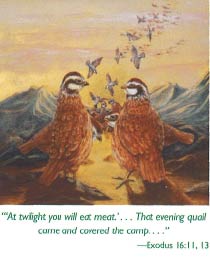
From living with and watching winged creatures, the writers drew spiritual lessons. God is like an eagle under whose wings we can find protective shelter (Ps. 91). God is gentle as a dove, descending over the baptismal river on his son—and on us (Mark 1). Jesus came to his people to love and care for them like a hen gathering her chicks under her wings (Matt 8:37).
Birds bring the ancient stories close to our own experience—and so they have become symbols of Christian realities and part of our spiritual vocabulary.
All of these ideas—and more—inspired noted artist Edgar G. Boevé to paint thirteen birds of the Bible. These 13"x13" paintings on gold leaf trace the biblical story from creation through the fall, to God’s provision for redemption. Boevé painstakingly researched the anatomy and coloring of each bird, but more ingenious is the story each painting tells, expounding the rich lessons already in the Bible.
Take, for example, the second in the series, “The Dove Returning to the Ark.” As in all the paintings, the orb of the sun is present, but here it is to the far left, hidden by slowly receding clouds. This dove, in contrast to the “Dove of the Holy Spirit” at creation, is alighting, not descending. It has found freedom; it is the only bird of the series—save the eagle—gleefully headed off the canvas.
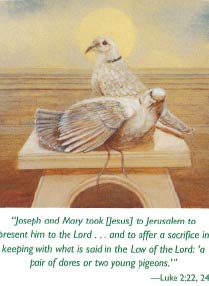
And that’s only the beginning. “The Sparrows Under Divine Care” immediately draws us to the wonderful circular flight of sparrows around the sun; but then we notice the one sparrow drinking from the water and discover that the pool is in the shape of an eye. In “Singing Birds Praising God,” many songbirds perch on five wires, their bulbous bodies turning into musical nomenclature on a staff. We are captivated by the innocence of the doves in “A Pair of Turtle Doves as Temple Sacrifice” and amazed that such contrasting subtleties could exist within the one color used for the dove, altar, and wall.
This magnum opus of Boevé inspired me with sermon idea after sermon idea. As each painting told its story from the Bible, I was moved again in my praise of God. In gathering material about the birds of the Bible, I found new insight into the Scriptures and a renewed friendship with the writers of the Bible. In viewing these paintings and taking a fresh look at Scripture, I know your thoughts will be stimulated and your hope renewed like the eagle’s.
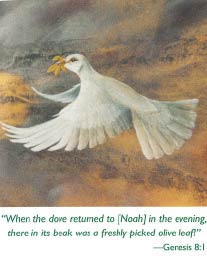
WEEK ONE
THE RAVEN AND DOVE
Note: for service elements you can use for each of these four services, see page 23.
Scripture
Genesis 6:1-9:3
Sermon Seed
In the beginning it must have been a great adventure for Noah and his sons: the excitement of building a new boat, being the talk of the town, the animals obediently marching to the ark, flashes and peals of thunder. History’s biggest rainstorm was about to begin.
Fast-forward the story about one hundred and fifty days. Everything inside the ark is damp. The air is putrid. Eight human beings and a menagerie of seasick animals are lulling and pitching in the rudderless ark. Hope gives way to despair as one gray, drizzly day turns into another. But the ark comes to rest on top of Mount Ararat and Noah flings wide the windows, letting in fresh air and the next chapter of this story.
Birds are prominent in Noah’s story; we read no less than eighteen references to them. And now, safely atop Ararat, Noah follows an ancient custom practiced by navigators lost at sea. When their ships were blown off course and out of sight of land, captains would release doves kept aboard in cages for such contingencies. The direction in which the doves flew indicated where the nearest land lay. Noah first decides to release a raven—a strong, muscular, and smart bird. (Ravens can even be taught to utter a few words.) With a four-foot wingspan, ravens cover large distances without growing tired and survive where smaller, weaker birds would perish. They fly very high, where their keen eyes can see for miles around. Noah’s raven kept “flying back and forth until the water dried up from the earth” (Gen 8:7).
Next Noah sends out doves—similar to our modern-day pigeons. Doves are well-suited for this task; they fly quickly and can cover long distances easily. The first dove, like the raven, could find no land. The second dove Noah sends out returns a week later with a freshly-plucked olive branch, proof that God’s world was alive again. The final dove, sent out a week later, never returned, definitive proof that there was viable life for God’s creatures.
The story ends with an altar, smoke, blue skies, green vegetation, and a colorful rainbow—and with the skies full of winged creatures.
Noah and the doves’ story reminds us of a God who will not give up on this world, even when it has collapsed under the weight of its own sin. There is always hope.
Congregational Song
“Like the Murmur of the Dove’s Song” PH 314, SFL 191, SNC, TWC 286
“In the Beginning” Burg
“Let All Creation Bless the Lord” SNC
“Praise the Lord, Sing Hallelujah” Kirkpatrick
“For Your Gift of God the Spirit” Clarkson
“All Things Bright and Beautiful” Alexander
Anthem Suggestions
“Like the Murmur of the Dove’s Song,” John Ferguson; SB voices and organ (GIA G-4948)
“Hear My Prayer,” Felix Mendelssohn (Foster 222). You could excerpt the famous soprano solo
“Oh, for the Wings of a Dove” and use as a solo.
“On Mighty Pens” from The Creation, Franz Josef Haydn; soprano solo (Schirmer 190)
WEEK TWO
HIS EYE IS ON THE SPARROW
Scripture
Matthew 6:25-27
Sermon Seed
An ancient story tells of Death coming to a city and being met at the gate by a man. The man asks Death what it has come to do. Death says that it will take 10,000 people from the city that day. The next day Death comes again. The same man is sitting at the gate again. This time, the man says to Death, “You said you came to take 10,000 people yesterday, but this morning’s news is that 70,000 died yesterday. Why did you do this?” Death answers, “I did take my 10,000—worry and anxiety killed the rest.”
We may think that worry and anxiety are unique to our culture and to our fast-paced days packed with high expectations. Not so.
Imagine the people of Jesus’ day. They press against Jesus, thirsty for answers. They wonder, Does he really care? Should they leave everything to follow Jesus? Did they do the wrong thing by leaving their work to follow Jesus? How would they feed their kids now? What would they eat and drink and wear tomorrow?
There on a hill beside the Sea of Galilee, Jesus points to the heavens to give an illustration his followers would never forget. On the shores of the Sea of Galilee were flocks of pelicans, flamingos, Indian darters, and giant herons, which inhabited only this region of Palestine. The birds would have taken wing at the approach of Jesus’ boat; if not, surely the “great crowds of people” would have frightened them.
To answer their concerns, Jesus simply points a finger to the air and says “Look at the birds of the air” (Matt. 6:26). Every eye looks up to the birds flying above. He continues, “They do not sow or reap or gather into barns”—an obvious fact. Can you imagine birds farming with a tractor or putting up hay? Of course not. Seeing the smiles on their faces, Jesus concludes, “Are you not much more valuable than they?”
When Jesus says that we are not to worry, he doesn’t mean we shouldn’t think about tomorrow. The Greek verb really means “don’t give anxious thought.” Jesus is not against thinking about tomorrow; he warns us against foreboding, not forethought. Again, a look at the birds illustrates this point. Like the birds in Boevé’s painting who are gathering their own food from the sunflower, birds work hard. They industriously scratch and peck all day long to find their food. But they don’t worry about it—they sense that their creator will provide.
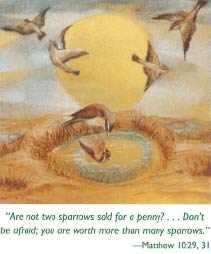
This truth is the heart of life. God cares for us and all creatures everywhere—even the drab, pesky, and overpopulated sparrow and the bloodthirsty raven (Matt 10:31; Luke 12:24). Christians understand Jesus’ point even before he asks the question “Are you not much more valuable than they?” They know that if God provides for sparrows, God certainly cares for us.
Congregational Song
“How Lovely Is Your House, O Lord” Roeper-Boulogne and Slenk
“Look and Learn from the Birds of the Air” (Korean) SNC
“Psalm 8” SNC
“Praise the Lord! O Heavens, Adore Him” Dirksen
“How Lovely Is Your Dwelling” Knecht and Husband
“Great Is Thy Faithfulness” Chisholm and Runyan
“If You But Trust in God to Guide You”
“How Great Thou Art” Hine
“Thy Holy Wings” WOV 741
“His Eye Is on the Sparrow” This Far By Faith 252, Lead Me, Guide Me 186
Anthem Suggestions
“Carol of the Cuckoo,” Carolyn Jennings; unison/2-part for Christmas with flute (Choristers Guild CGA-228)
“O How Amiable,” Ralph Vaughan Williams; SATB and organ (Oxford 42.056)
“Psalm 84,” Paul Bouwman; SATB and organ (Augsburg 11-11002)
WEEK THREE
THE SON OF MAN HAS NO PLACE
Scripture
Matthew 8:20; Matthew 23:37
Sermon Seed
Just before Jesus said to his disciples, “Birds of the air have nests, but the Son of Man has no place to lay his head,” we are told that Jesus crossed to “the other side of the lake.” Most likely this was the region of Capernaum on the northwestern coast of the Sea of Galilee, an area where there are low pine trees stuffed full of birds’ nests. You can almost hear the chirping counterpoint above Jesus’ voice in this text. Even frail birds who build their homes on precarious and unpredictable places have homes; Jesus does not.
Boevé’s painting of this text is itself a sermon. We see crown sparrows nesting on fence rails in the shape of the cross. They are surrounded by grapevines—a triple metaphor of communion, Christ the vine, and we the branches destined to bear fruit.
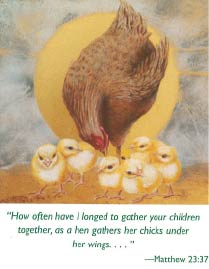
Christ would find his home for us on the cross of Calvary. On his way to Calvary, Jesus compares himself, in one of the tenderest passages of Scripture, to a hen in a poultry yard, evoking an unforgettable scene. A brood of freshly hatched yellow chicks scampers across an open space, peeping loudly while their nervous mother hen clucks at them. Overhead, as if out of nowhere, a hawk dives, wings folded, keen eyes gleaming, talons open, ready to grab a chick. But the hen’s eye is also sharp, and she quickly collects her chicks (in Boevé’s painting seven symbolic chicks gather) and hides them under her wings. “O Jerusalem, Jerusalem . . . ,” laments Jesus, “how often I have longed to gather your children together, as a hen gathers her chicks under her wings, but you were not willing” (Matt. 23:37).
God gathered Israel under his wings, delivering them from bondage, giving them quail to eat in the wilderness and providing for their every need. But when the Son of God came to his people offering protection, care, and love, they rejected him.
No wonder Jesus wept.
But we rejoice. Even though Jesus’ wings would be crucified and bruised for our iniquities, no ultimate evil will come to us. Jesus has taken it all. He protects us. There is a hand in the darkness, a God who knows and calls us by name, a God who will never let go of his grip on us.
Congregational Song
“O Lord, My God, Most Earnestly” Stebbins
“See, Christ Was Wounded for Our Sake” Recker and Foley
“I Am the Holy Vine” Ireland
“Psalm 148” SNC
“Spirit Song” SNC
“Praise to the Lord, the Almighty” Neander and Lang
“The Head That Once Was Crowned with Thorns” Clark and Kelly
“Shelter Me, O God” Gather 276, SNC
Anthem Suggestions
“Jerusalem,” Felix Mendelssohn, St. Paul; soprano solo (G. Schirmer 321)
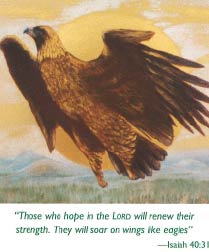
WEEK FOUR
ON EAGLES WINGS
Scripture
Isaiah 40:28-31; Revelation 4-5
Sermon Seed
The heat was intense on the island of Patmos. John was doing hard labor for the Roman government because he remained loyal to Christ and refused to worship the Roman emperor. This penal island was surrounded by the beautiful Aegean Sea whose clear water must have appeared “as a sea of glass, as clear as crystal” to him. But this was no day spa for John.
To get through his days, John hoped and prayed for the new day coming. He dared to compose a beautiful hymn of faith for the church:
Never again will they hunger;
never again will they thirst.
The sun will not beat upon them,
nor any scorching heat.
For the Lamb at the center of the throne will be their shepherd;
he will lead them to springs of living water.
And God will wipe away every tear from their eyes.
—Revelation 7:16-17
During those hard days, God gives John a vision of a huge, cosmic battle that will be like a woman defeating a dragon. Once the war is over and the dragon slain, the woman will leave with “two wings of a great eagle, that she might fly to the wilderness” (Rev. 12:14).
With this image John recalls verses that extol the mystique of the eagle: the ease of its gravity-defying flight (some eagles have been clocked in a 120- mph dive), the grandeur of its stature, the cunning skill of its hunting. These qualities are apparent in Boevé’s painting; the girth of an eagle soaring to the heavens appears even bigger than the huge sun behind it.
In the Bible the eagle is a symbol of spiritual experience. When we trust God, we discover the enormous lifting power of faith and hope: “They that wait upon the Lord shall renew their strength, they shall mount up with wings as eagles” (Isa. 40:31). The psalmist praised the Lord for renewing his youth like the eagle’s (Ps. 103:5, based on an old idea that eagles renew their youth by soaring toward the sun). Eagles have a long life—some have been known to live up to eighty years. So mysterious was the eagle of biblical times that it attained a godlike quality. No wonder the Bible mentions “wings” and “flying” in connection with God again and again.
John knew that no matter how hard life is, a day is coming when we will rise up on eagle’s wings. We will belong to a city whose architect and builder is God. This hope became reality in Jesus Christ. It is our hope today.
In Revelation 4-5 John writes no less than five songs of praise to the One seated on the throne and to the Lamb. He declares that Christ, the hope-giver, is worthy of all our praise. And to that the heavenly-winged lion, the ox, the human, and the flying eagle cry “Amen.”
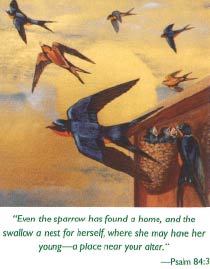
Congregational Song
“On Eagles’ Wings” (Psalm 91) SFL 205, SNC
“By the Sea of Crystal” Kuipers and Vanderhoven
“Come, Praise the Lord, My Soul” Otte and Slenk
“Creation Sings, Each Plant and Tree” SNC
Anthem Suggestions
“They Shall Soar Like Eagles,” Laura Manzo; SAB with optional flute obbligato (Fred Bock,
BG 2078)
“City of Heaven,” arr. Josephine Poelinitz (Plymouth Music HL-105)
“Wings Like Eagles,” Allen Pote; SATB (Hope Publishing C5049)
“On Eagles’ Wings,” Michael Joncas; SATB (Hope Publishing A675)
“I’m Goin’ Up A Yonder,” Walter Hawkins; four-part treble; (Bossey & Hawkes OCTB6451)
Service Elements
Note: Service elements for all four weeks in the series.
Call to Worship
Psalm 84 (different sung or spoken settings)
*Call to Confession
Christ our Lord invites all who love him,
who earnestly repent of their sin
and seek to live in peace with one another.
Therefore let us confess our sin before God and one another.
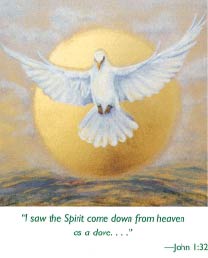
Prayer of Confession
O God, who brooded over the world when it was created,
and broods now over your children
until we are shaped in the image of Christ,
we confess our daily sins:
the word sharply spoken,
the praise withheld,
the embrace not given,
the hurt disguised,
the envy felt,
the self indulged,
the need neglected.
Receive us now broken, penitent, wishing it were otherwise.
Enfold us in the arms of love and forgiveness, and restore a new spirit within us.
Make us one with ourselves, with each other, with you.
Let your name be magnified, let Christ be glorified, let the Holy Spirit be intensified,
in each heart and on all our lips, this day and forever.
Amen.
—John Killinger, Lost In Wonder, Love & Praise: Prayers and Affirmations for Christian Worship, p. 49. © 1986, Angel Books, Lynchburg, VA 24503. Used by permission.
Alternatively, the congregation could sing Psalm 139, “Lord, You Have Searched Me” Post and Oliver
*Assurance of Pardon
Leader: Hear the good news: Christ died for us while we were yet sinners; that proves God’s love for us. In the name of Jesus Christ, you are forgiven!
People: In the name of Jesus Christ, you are forgiven!
All: Glory to God. Amen.
Hymn of Response
“Spirit of God, Descend upon My Heart” Croly and Arkinson
Prayer for Illumination
“Spirit Divine, Inspire Our Prayers” Reed and Cruger
Artist’s Reflections on “God’s Aviary”
In the Bible and in other religious writings, every winged being symbolizes spiritual truths. Folklore all over the world uses the bird as a symbol of the soul. Myths and folktales universally depict birds as collaborator with humans and often as celestial messengers. They are symbols of thought, of imagination, and, as airborne creatures, of swiftness of spiritual processes and relationships. The Bible is particularly rich in its reference to birds that express spiritual truths.
For “God’s Aviary,” I have chosen thirteen birds:
- The dove of the Holy Spirit as it hovers over the universe; Genesis 1:2 and John 1:32.
- The dove as it returns to Noah in the ark after the flood; Genesis 8:8-12.
- The quail God sent each evening to feed the Israelites in the wilderness; Exodus 16:13.
- The swallows that nest “near your altar”; Psalm 84:3.
- The golden eagle rising above the landscape; Isaiah 40:31 and Psalm 103:5.
- Singing birds praising God; Psalm 104:12.
- Migrating white storks as pilgrims, which also have great fidelity to their nesting site; Jeremiah 8:7 and Psalm 104:17.
- A pair of turtledoves as the temple sacrifice brought by Mary and Joseph at their presentation of Jesus; Luke 2:23-24.
- The sparrows under divine care; Matthew 10:29-31.
- A hen with seven chicks, expressing Christ’s love for his children; Matthew 23:37.
- Three feeding birds on a sunflower, expressing God’s constant care; Matthew 6:26.
- Crown sparrows nesting among grapevines, while “the Son of Man has no place to lay his head”; Luke 9:58.
- The cock crowing at dawn (Peter’s denial); Matthew 26:34, 75.
The sun is a significant element in each painting as a symbol of true light (see Ps. 27:1; John 8:12). It is also.

